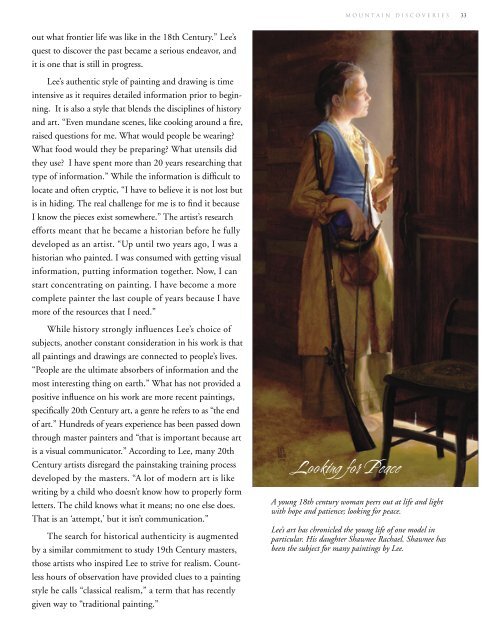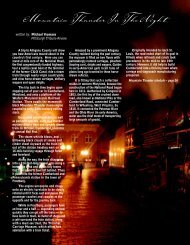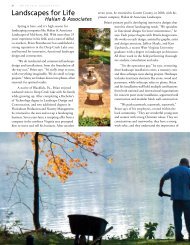Lee Teter - Mountain Discoveries Magazine
Lee Teter - Mountain Discoveries Magazine
Lee Teter - Mountain Discoveries Magazine
You also want an ePaper? Increase the reach of your titles
YUMPU automatically turns print PDFs into web optimized ePapers that Google loves.
out what frontier life was like in the 18th Century.” <strong>Lee</strong>’s<br />
quest to discover the past became a serious endeavor, and<br />
it is one that is still in progress.<br />
<strong>Lee</strong>’s authentic style of painting and drawing is time<br />
intensive as it requires detailed information prior to beginning.<br />
It is also a style that blends the disciplines of history<br />
and art. “Even mundane scenes, like cooking around a fire,<br />
raised questions for me. What would people be wearing?<br />
What food would they be preparing? What utensils did<br />
they use? I have spent more than 20 years researching that<br />
type of information.” While the information is difficult to<br />
locate and often cryptic, “I have to believe it is not lost but<br />
is in hiding. The real challenge for me is to find it because<br />
I know the pieces exist somewhere.” The artist’s research<br />
efforts meant that he became a historian before he fully<br />
developed as an artist. “Up until two years ago, I was a<br />
historian who painted. I was consumed with getting visual<br />
information, putting information together. Now, I can<br />
start concentrating on painting. I have become a more<br />
complete painter the last couple of years because I have<br />
more of the resources that I need.”<br />
While history strongly influences <strong>Lee</strong>’s choice of<br />
subjects, another constant consideration in his work is that<br />
all paintings and drawings are connected to people’s lives.<br />
“People are the ultimate absorbers of information and the<br />
most interesting thing on earth.” What has not provided a<br />
positive influence on his work are more recent paintings,<br />
specifically 20th Century art, a genre he refers to as “the end<br />
of art.” Hundreds of years experience has been passed down<br />
through master painters and “that is important because art<br />
is a visual communicator.” According to <strong>Lee</strong>, many 20th<br />
Century artists disregard the painstaking training process<br />
developed by the masters. “A lot of modern art is like<br />
writing by a child who doesn’t know how to properly form<br />
letters. The child knows what it means; no one else does.<br />
That is an ‘attempt,’ but it isn’t communication.”<br />
The search for historical authenticity is augmented<br />
by a similar commitment to study 19th Century masters,<br />
those artists who inspired <strong>Lee</strong> to strive for realism. Countless<br />
hours of observation have provided clues to a painting<br />
style he calls “classical realism,” a term that has recently<br />
given way to “traditional painting.” given way to “traditional<br />
painting.”<br />
m o u n t a i n d i s c o v e r i e s 33<br />
Looking for Peace<br />
A young 18th century woman peers out at life and light<br />
with hope and patience; looking for peace.<br />
<strong>Lee</strong>’s art has chronicled the young life of one model in<br />
particular. His daughter Shawnee Rachael. Shawnee has<br />
been the subject for many paintings by <strong>Lee</strong>.




